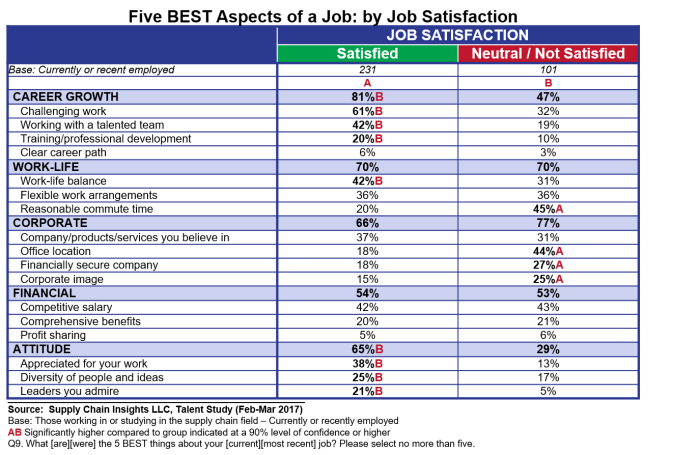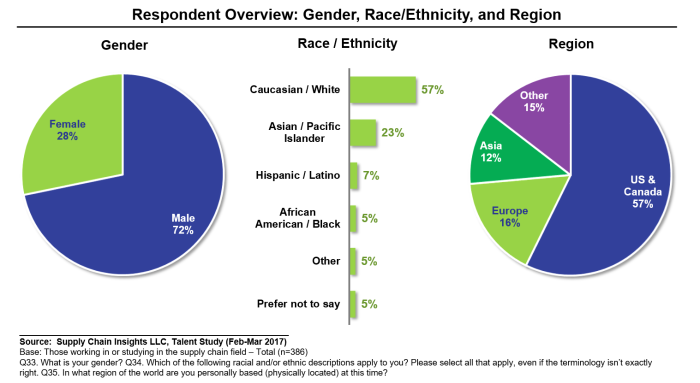A New Mission for a Female Supply Chain Pioneer
 This week I have been working with the Supply Chain Insights team to analyze and write our annual supply chain talent report. With over 400 respondents in the study, cross-tabbing and data analysis was fun. We had many options.
This week I have been working with the Supply Chain Insights team to analyze and write our annual supply chain talent report. With over 400 respondents in the study, cross-tabbing and data analysis was fun. We had many options.
High-Level Findings
In general there is high job satisfaction in supply chain careers: 70% are either very satisfied or satisfied with their current job. The most satisfied are Baby Boomers working for technology companies.
The baton is being passed from Baby Boomers to Generation X. There are stark differences. While Baby Boomers are willing to work longer hours, and focus on improving traditional processes, Generation X and Millennials are pushing to drive change and adopt next-generation processes. Note the higher satisfaction of employees in Figure 1 when there is challenging work, clear career paths, strong training programs in an environment when employees feel appreciated, and there is a culture of strong leadership which encourages diversity of thought.
Figure 1. Best Aspects of the Supply Chain Job

Supply Chain Profession Evolving
The supply chain profession is evolving. We don’t have all the answers because it is relatively new.
The use of the term ‘supply chain management’ to describe make, source, and deliver as a function is relatively new. While we have centuries of building logistics and transportation teams, the term supply chain management was first defined in 1982. Within manufacturing companies, 1/3 of leadership teams have a supply chain human resource teams, yet only 50% are effective.
For me, as I wrote the report, one thing was clear: supply chain management is still a white male profession. Only 28% of the respondents were female and 57% were Caucasian. Sadly, diversity in the profession remains an issue. I thought we had made more progress.
Figure 2. Diversity of Respondents

By and large, supply chain professionals in both genders have similar goals and aspirations. The only difference is the need for work from home, flex/hours and commuting considerations. I think the issue is that we are not building aspirations for supply chain management in young females in high schools and in the larger community.
Figure 3. Differences in Gender Characteristics

A year ago I attended a badly facilitated women’s networking conference. I left angry. As a first-generation female supply chain pioneer, I felt the content was patronizing and underserved the greater need. I was looking for a forum of women leaders building women leaders. As I looked around the room I was disturbed. Why? There were few women of color. I believe in diversity.
To be successful, I believe supply chain management needs diversity. I want to work in a career that is inclusive. Note that the differences in drivers for job satisfaction are greater by ethnicity than by sex. Employees of color are seeking greater career path opportunities, more diversity in the workforce, and greater benefits.
Figure 4. Differences in Drivers/Characteristics of Employment Opportunities by Ethnicity.

 I was an early supply chain pioneer in the 1980s. In those days there were few females or people of color. After four decades I thought we had made more progress. In working on this report, I realize that I need to fight harder. As a result, this year I will be focus on several actions:
I was an early supply chain pioneer in the 1980s. In those days there were few females or people of color. After four decades I thought we had made more progress. In working on this report, I realize that I need to fight harder. As a result, this year I will be focus on several actions:
1) Speaking at US Colleges with Strong Minority Populations. Over the last three years I participated in career days, and networked academics with large companies recruiting efforts, to try to find greater placement for students of color. The report reminds me I need to stay focused on this mission.
2) Networking at the Imagine 2017 Conference. At this year’s 2017 Imagine conference I will be hosting a networking session to help companies better understand and embrace the needs of a diverse workforce. We need to move past self-serving and patronizing groups to build a global and diverse workforce.
3) Hiring and Mentoring. During the year I will look for opportunities to hire and mentor diverse candidates. I will staff my events with students of color and hire co-ops with this intent in mind.
I hope you will join me in making supply chain management more inclusive. For greater insights on the current state of talent, today we share our full report to help global supply chain teams. In addition, we also share the powerpoint slides. We welcome your thoughts.
No comments:
Post a Comment